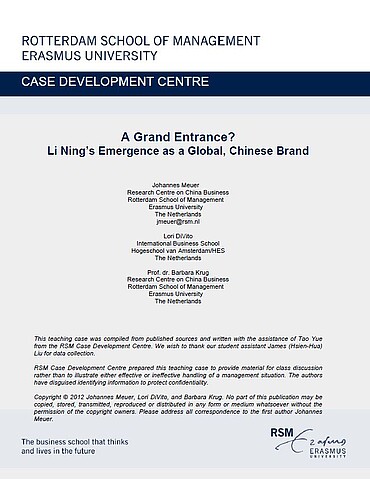Citation Note
Based on Published sources; 17 pages. Winner (ECCH Case Awards) 2012.
Follow the 'handle' link to access the Case Study on RePub.
For EUR staff members: the Teaching Note is available on request, you can contact us at rsm.nl/cdc/contact/
For external users: follow the link to purchase the Case Study and the Teaching Note.
Objective
The objective of this teaching case is for students to better understand the complexity of Chinese firms’ international expansion: What objectives should a company set? What strategy should it adopt? What activities should it engage in? What is the best timing? What are the best markets for internationalization and how should they be approached? How are the necessary capabilities identified and how should they be developed? How political and cultural factors influence internationalization strategies?
description
Li Ning, the biggest Chinese sportswear firm, must deal with the dilemma between committing resources to international expansion and maintaining a leading position in an increasingly competitive domestic market.
Abstract
Li Ning Co. Ltd. (Li Ning), a Chinese sport apparel, footwear, and equipment company founded in 1989 by the Olympic gymnastics gold medallist, grew from a family business into China’s number one sporting goods brand in less than two decades. Its products, generally considered price-quality bargains, were distributed throughout China. The company’s ambition was not confined to the home market, however. It went public in 2004 on the Hong Kong Stock Exchange, where it raised $US 70.5 million to establish itself as an international brand, competing with brands like Adidas, Nike, and Reebok. It stepped up international marketing and exports, set up R&D centers overseas, distributed European brands in China, and sponsored international sporting events. In 2007, Li Ning made its first attempt to directly access foreign markets by opening a flagship store in Maastricht, the Netherlands. When it speeded up internationalization by opening stores in Southeast Asia, Hong Kong and the US from 2009 to 2010, its business at home faced major challenges as competition from both international and local rivals intensified. Committing resources to internationalization, therefore, became harder to justify. Li Ning had to decide whether to further expand internationally and, if so, whether to remain a price fighter or develop a more differentiated strategy.
usage
The case demonstrates the complexity of a Chinese firm’s internationalization strategy, in particular the question of resource allocation between home market and abroad, especially in light of heightened competition in the Chinese market.
